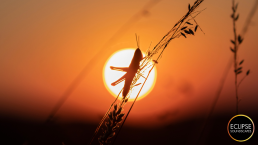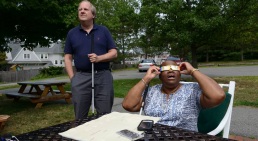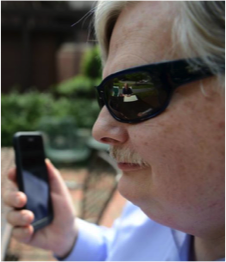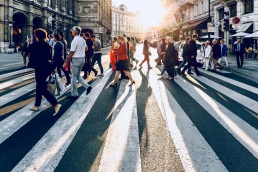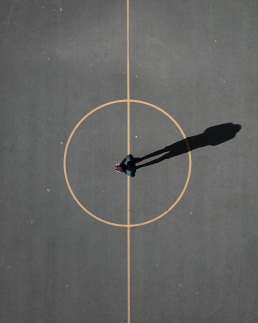In the News
In a giant leap for STEAM accessibility, the Eclipse Soundscapes Citizen Science Project is selected for NASA SciAct Award
Medford, Mass. — The Eclipse Soundscapes: Citizen Science Project (ES:CSP), an enterprise of ARISA Lab, has been approved for a five year cooperative agreement from the NASA Science Mission Directorate’s SciAct Program and will now be supported by NASA under award No. 80NSSC21M0008. ES:CSP will engage NASA subject matter experts (SMEs) with citizen scientists to explore how U.S. ecosystems are impacted by solar eclipses, such as those upcoming in 2023 and 2024. The project will promote inclusive and accessible learning, with a special focus on people who are blind or low vision (BLV).
“The Eclipse Soundscapes Project launched with the intention of making the 2017 total solar eclipse exciting and engaging for everyone, including people who are blind or low vision,” said Dr. Henry Winter, who co-founded ARISA Lab alongside MaryKay Severino.
The project was inspired by anecdotal accounts, including an early citizen science initiative from 1935, that suggest animal behavior may change during a total solar eclipse. A friend once told Dr. Winter that at the moment of totality, when the moon blocked out the sun, a chorus of crickets began chirping. As soon as the light returned, the crickets stopped. "It dawned on me that eclipses affect the earth in ways that can be experienced and measured using a variety of senses, and that we could study eclipses in ways that were not only visual," Dr. Winter said.
The newest Eclipse Soundscapes project will introduce accessible opportunities for citizen scientists to participate in eclipse research. Through a series of workshops led by NASA SMEs, citizen scientists will collect audio recordings from eclipses and analyze acoustic data to determine how disruptions in light and circadian rhythms may affect ecosystems. The data will include soundscapes recorded by the National Park Service and Brigham Young University during the 2017 total solar eclipse, as well as recordings from the upcoming 2023 annular eclipse and 2024 total solar eclipse.
All workshops, materials, and learning interfaces will be designed to the highest degree of accessibility, with an emphasis on physical, social, and cognitive inclusion.
The mission to make science accessible to everyone will be supported through a number of partnerships. An advisory board of bio-acoustic scientists will help guide ARISA in the analysis and interpretation of the soundscapes data. The board consists of Dr. Megan McKenna of Stanford University’s Goldbogen Lab, Dr. Bryan C. Pijanowski of Purdue University’s Center for Global Soundscapes, Dr. Laurel Symes of The Cornell Lab of Ornithology’s Center for Conservation Bioacoustics, and Sound and Light Ecology Team Research Associate Dr. Jacob Job. The National Federation of the Blind, the GBH National Center for Accessible Media, and BLV Consultant Lindsay Yazzolino will provide external evaluations and accessibility consulting. Regine Gilbert and her students in the Integrated Digital Media Program at New York University Tandon School of Engineering will design, implement, and test ES:CSP web interfaces. The NASA Space Science Education Consortium will assist with networking and promotion of NASA SME-led events, and it’s STEAM Innovation Lab will produce tactile and accessible education and presentation materials. Along the way, feedback from BLV users and workshop participants will inform accessibility choices and best practices.
The ultimate goal of the project is not only to cultivate a fun and educational experience surrounding the exciting natural phenomenon of an eclipse, but to develop an inclusive framework for improved accessibility and engagement in STEAM.
The Advanced Research in STEAM Accessibility (ARISA) Lab creates innovative technology solutions and resources for educators, under-represented learners, and client organizations to increase engagement with Science, Technology, Engineering, Art, and Math (STEAM). All of ARISA’s products are designed with accessibility in mind from the beginning to increase engagement and ease of use for all users.
###
Disclaimer: Any opinions, findings, and conclusions or recommendations expressed in this material are those of the author(s) and do not necessarily reflect the views of the National Aeronautics and Space Administration.
January 25, 2021
The Eclipse Soundscapes Project's Eclipse Mobile App is Added as a Major Milestone in Accessibility
To commemorate the 30th anniversary of the Americans with Disabilities Act WGBH Studios has compiled a list of major milestones in accessibility. The list includes the Eclipse Soundscapes Project's Mobile App that made the 2017 Total Solar Eclipse accessible and engaging for everyone, including people who are blind and visually impaired. You can read more about the evolution of accessibility at WGBH.org.
August 28, 2020
For Those Who Can’t See, The Eclipse of the Century Was One for the Senses
WGBH photographer Meredith Nierman followed blind and visually impaired people using the Eclipse Soundscapes app and NASA braille book on the day of the eclipse in Boston.
May 7, 2020
How to Watch a Solar Eclipse
The extensive NYT science guide to the eclipse included information about the Eclipse Soundscapes project amidst citizen science initiatives.
May 7, 2020
How Weird Will Wildlife Get During the 2017 Solar Eclipse?
The Audubon Society’s website included the Eclipse Soundscapes project in an article about research to determine the effect of the eclipse on wildlife.
May 7, 2020
Voices
The Global Voice, which is promoted as “interviews with interesting people from around the world” featured Dr. Winter in a segment about participating in the Eclipse Soundscapes Project.
May 7, 2020
Total Eclipse of the Sun
Another Science News reporter interviewed Dr. Winter in this podcast about citizen science projects scheduled to take place during the eclipse.
May 7, 2020
How One Astrophysicist Is Helping The Blind 'See' Monday's Solar Eclipse
A segment of WGBH News, Curiosity Desk interviewed Dr. Winter and featured the Eclipse Soundscapes app in a six minute radio segment.
May 7, 2020
NASA taps citizen scientists to help study eclipse
While this article had some factual errors, its interview with Dr. Winter stressed the importance of including citizen scientists in the Eclipse Soundscapes Project regardless of access to expensive equipment.
May 7, 2020
What Does an Eclipse Sound Like?
In their “innovation” section, the Smithsonian published this feature length story featuring interviews with the Eclipse Soundscapes and National Center for Accessible Media teams.
May 7, 2020
